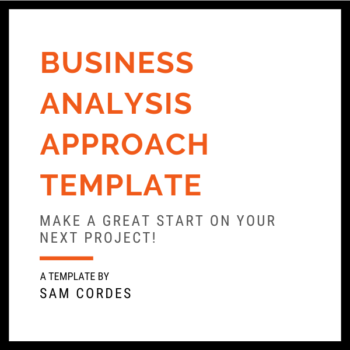
Business Requirements Document Template
$9.00
Deliver full coverage of your requirements with the Business Requirements Document Template. When you’ve completed your BRD you will have provided comprehensive coverage of the business requirements. It will describe to your business stakeholders an overview of the proposed solution, and why it is needed in non-technical language. And it will give enough information for vendors or developers to translate into detailed and actionable technical requirements.
Description
Be seen as the BA who delivers value and succeeds
- Are you implementing a new system and you’re unsure about what should go in to a Business Requirements Document?
- Do you need to produce a comprehensive BRD and need guidance on how to confidently put this document together?
- Would you be interested in a template that provides structure and examples on how to write a good quality deliverable?
A note about your author
I’m Sam Cordes, Business Analyst. I’ve been employed professionally as a BA for well over 20 years in various industries, most of that time as a contractor. In addition to my own work, I have often provided mentoring and knowledge transfer to my colleagues to support them in their careers, and promote organisational capability. Following good practice and producing quality products is what inspires me, and I’m passionate about helping others achieve the best they can in their business analysis career.
Here’s what you’ll get in your Business Requirements Document Template
This fully annotated template is a structured document with headings and sub-headings. Each heading contains examples to follow, and tables and lists for you to complete.
There are seven main sections in this template.
- Section 1 | Introduction. Orientates the reader by providing the overall purpose and context of the document. Your readers will know exactly what the BRD is aiming to achieve.
- Section 2 | Organisational Context. Describing the reasons why for the project, this section gives background context and the problem statement.
- Section 3 | System Overview. Provides the reader with a non-technical overview of the current system and the proposed solution so that they can visualize what the system will look like.
- Section 4 | Implementation Overview. If you’re required to address an implementation approach, then this section will provide an overview of the framework in which the system will be implemented. The examples give you the exact wording that you can adjust to your needs.
- Section 5 | Business Requirements. This is the meat of the document! The template is set up for you to include process maps for each functional area of the business, and the requirements that trace to each activity in the process.
- Section 6 | System Requirements. This section is optional, but it is included here because in some cases you’ll also need to address the functional and non-functional qualities of the system. This is so a vendor or developer has enough coverage of the requirements to translate into a proposed technical solution.
- Section 7 | Definitions. This section defines all of the terminology and acronyms used throughout the document and includes the roles and responsibilities of all stakeholders involved in, or impacted by, the change.
When you’ve completed your Business Requirements Document Template you will have provided comprehensive coverage of the business requirements. It will describe to your business stakeholders an overview of the proposed solution, and why it is needed in non-technical language. And it will give enough information for vendors or developers to translate into detailed and actionable technical requirements.
My Guarantee
I know you are going to get results, but if you are not entirely happy I’ll send back every penny you paid.
You may also be interested in...
-
Business Analysis Approach Planning Template
$9.00 Add to cartMake a great start on your next project with the Business Analysis Approach Template. This template helps you set the expectations on how you perform your work, the resources you need and the types of activities you will engage in, e.g. workshops and interviews. So everybody is on the same page! Planning also increases the transparency of your work as the small processes of your analysis are better understood. This helps when expectations have to change. A well written plan will help you communicate exactly what’s required of you and your stakeholders to produce the necessary deliverables for your business analysis effort, and why.
-
Business Case Template
$9.00 Add to cartWrite a comprehensive and compelling case for change with the Business Case Template. This fully annotated template is a structured document with headings and sub-headings. Each heading contains examples to follow, and tables and lists for you to complete. Suitable for analysing technology options and implementation approaches in depth, this template gives you a structured approach to; analysing options and making a recommendation; describing the costs, benefits and risks of that recommendation; and writing an outstanding executive summary, or ‘case for change’.
-
The Career Transformation Handbook
$9.00 Add to cartAn e-book that transforms struggling business analysts into thriving professionals! Complete with downloadable worksheets, inside I will teach you how choose the career path that you want, and be a business analyst that delivers value and succeeds. You will learn how to set achievable goals, develop your professional profile, identify and leverage career opportunities, and ensure amazing success.


